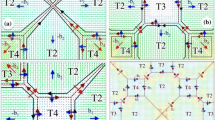Abstract
The stability, bonding, work of adhesion and electronic structure of the U/W interface with and without Ti were investigated by first principles to explore the mechanical properties of W particles enhanced U–Ti alloy matrix composite as a construction material. The calculated results indicate that the preferable orientation of the U/W interfacial structure is (001)U/(110)W crystallographic plane, Ti atoms originating from U slab are prone to diffuse into W slab through the interface, and additional Ti in U matrix is the stronger adhesion to W, with an ideal work of adhesion of 6.93 J·m−2 for U–Ti/W interface, relative to the value of 6.72 J·m−2 for clean U/W interface. The stronger adhesion performance is due to the increase in valence electron hybridization for U–Ti/W compared with U/W interface, as evidenced by the characteristic of the local density of states for the interfacial atoms.






Similar content being viewed by others
References
Kim KH, Lee DB, Kim CK, Hofman GE, Paik KW. Characterization of U-2 wt% Mo and U-10 wt% Mo alloy powders prepared by centrifugal atomization. J Nucl Mater. 1997;245(2–3):179.
Liu YJ, Yu D, Du Y, Sheng G, Long ZH, Wang J, Zhang LJ. Atomic mobilities, diffusivities and their kinetic implications for U–X (X = Ti, Nb and Mo) bcc alloys. CALPHAD. 2012;37:49.
Udy MC, Boulger FW. Uranium–titanium alloy system. Trans AIME. 1954;200:207.
Schramm CH, Gordon P, Kaufmann AR. The alloy systems uranium–tungsten, uranium–tantalum, and tungsten–tantalum. Trans AIME. 1950;188:195.
Ackermann RJ, Rauh EG. Measurements of solubilities and derived thermodynamic properties of tungsten and tantalum in liquid thorium and uranium. High Temp Sci. 1972;4(6):496.
Saroja A, Bhatt YJ, Garg SP. Determination of thermodynamic properties of liquid Th–Mo, U–Mo, Th–Ta, U–Ta, Th–W, and UW alloys from their diagrams. J Less Common Met. 1985;114(2):291.
Chandrasekharaiah MS, Dharwadkar SR, Das D. High-temperature phase diagrams of Re–U, Ta–U, and W–U. Z Metallkd. 1986;77(8):509.
Berche A, Dupin N, Guéneau C, Rado C, Sundman B, Dumas JC. Calphad thermodynamic description of some binary systems involving U. J Nucl Mater. 2011;411(1–3):131.
Ilo S, Just Ch, Badisch E, Wosik J, Danninger H. Effects of interface formation kinetics on the microstructural properties of wear-resistant metal–matrix composites. Mater Sci Eng A. 2010;527(23):6378.
Kennedy AR, Wyatt SM. Characterizing particle–matrix interface-al bonding in particulate Al–TiC MMCs produced by different methods. Compos Part A. 2001;32(3-4):555.
Hohenberg PC, Kohn W. Inhomogeneous electron gas. Phys Rev. 1964;136(3B):B864.
Kohn W, Sham LJ. Self-consistent equations including exchange and correlation effects. Phys Rev. 1965;140(4A):A1133.
Kresse G, Furthmuller J. Efficient iterative schemes for ab initio total-energy calculations using a plane-wave basis set. Phys Rev B. 1996;54(16):11169.
Perdew JP, Burke K, Ernzerhof M. Generalized gradient approximation made simple. Phys Rev Lett. 1996;77(18):3865.
Blochl PE. Projector augmented-wave method. Phys Rev B. 1994;50(24):17953.
Kresse G, Joubert D. From ultrasoft pseudopotentials to the projector augmented-wave method. Phys Rev B. 1999;59(3):1758.
Qi JB, Ren YG, Wu GX, Zhang JY, Kuochih C. Effects of Ti on electronic structure and mechanical property of uranium: a first-principles study. In: TMS 2012 Supplemental Proceeding: Materials Properties, Characterization, and Modeling. TMS Annual Meeting, Orlando, 2012;2: 699
Söderlind P, Eriksson O, Johansson B, Wills JM. Electronic properties of f-electron metals using the generalized gradient approximation. Phys Rev B. 1994;50(11):7291.
Söderlind P. First-principles elastic and structural properties of uranium metal. Phys Rev B. 2002;66(8):085113.
Crocombette JP, Jollet F, Nga TL, Petit T. Plane-wave pseudopotential study of point defects in uranium dioxide. Phys Rev B. 2001;64(10):104107.
Christopher DT. Evaluation of first-principles techniques for obtaining materials parameters of α-uranium and the (001) α-uranium surface. Phys Rev B. 2008;77(9):094119.
Kucharczyk R, Jurczyszyn L, Hadzel P. Adsorption of thin films of titanium on tungsten (111) surface. Surf Sci. 2010;604(17–18):1524.
Zarshenas M, Asadabadi JS. Theoretical study of α-U/W(110) thin films from density functional theory calculations: structural, magnetic and electronic properties. Thin Solid Films. 2012;520(7):2901.
Bihan LT, Heathman S, Idiri M, Lander GH, Wills JM, Lawson AC, Lindbaum A. Structural behavior of α-uranium with pressures to 100 GPa. Phys Rev B. 2003;67(13):134102.
Gaffet E, Louison C, Harmelin M, Faudot F. Metastable phase transformations induced by ball-milling in the Cu W system. Mater Sci Eng A. 1991;134:1380.
Luniakov YV. First principle simulations of the surface diffusion of Si and Me adatoms on the Si(111) \( \sqrt 3 \) × \( \sqrt 3 \)-Me surface, Me = Al, Ga, In, Pb. Surf Sci. 2011;605(19–20):1866.
Zhang X, Wang CY. First-principles study of vacancy formation and migration in clean and Re-doped γ′-Ni3Al. Acta Mater. 2009;57(1):224.
Barbosa KO, Assali LVC, Machado WVM, Justo JF. Structural and electronic properties of Ti impurities in SiC: an ab initio investigation. Comput Mater Sci. 2004;30(1–2):57.
Zhang SB, Northrup JE. Chemical potential dependence of defect formation energies in GaAs: application to Ga self-diffusion. Phys Rev Lett. 1991;67(17):2339.
Jiang DE, Carter EA. Prediction of strong adhesion at the MoSi2/Fe interface. Acta Mater. 2005;53(17):4489.
Qi Y, Louis GHJ, Newton O, James BA. A first principles study of adhesion and adhesive transfer at Al(111)/graphite(0001). Surf Sci. 2005;581(2–3):155.
Abhijit C, Syuichi N, Fujio M. Structure and property correlation for Ag deposition on α-Al2O3—a first principle study. J Mol Gr Modell. 2005;23(5):447.
Gong HR. Electronic structure and related properties of Pd/TiAl membranes. Intermetallics. 2009;17(7):562.
Acknowledgments
The work was financially supported by the National Natural Science Foundation of China (Nos. 51074103 and 51104098) and shanghai university scientific selection and cultivation for outstanding young teachers in special fund and Innovation Program of Shanghai University (SDCX2012011).
Author information
Authors and Affiliations
Corresponding author
Rights and permissions
About this article
Cite this article
Qi, JB., Ru, LL., Wu, GX. et al. First principles application for mechanical properties of Ti-doped W particles enhanced U matrix composite. Rare Met. 37, 815–822 (2018). https://doi.org/10.1007/s12598-015-0512-7
Received:
Revised:
Accepted:
Published:
Issue Date:
DOI: https://doi.org/10.1007/s12598-015-0512-7




